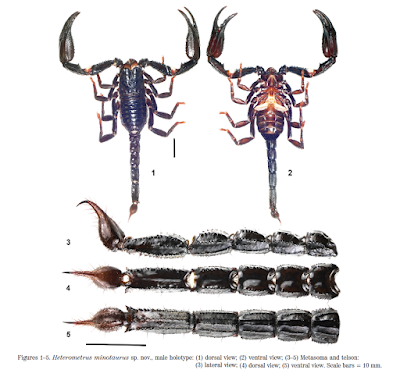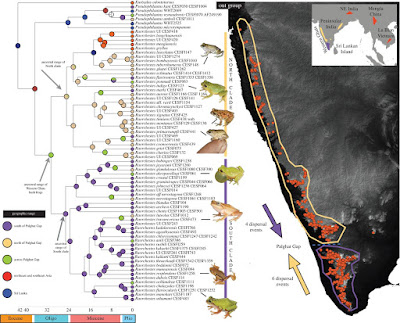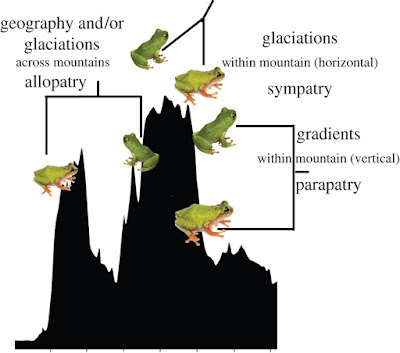[Most Recent Entries] [Calendar View]
Saturday, September 3rd, 2016
| Time | Event | ||
| 6:03a | [Invertebrate • 2016] Heterometrus minotaurus • A New Species of Heterometrus Ehrenberg, 1828 (Scorpiones: Scorpionidae) from Thailand with Remarks About the Utilization of Cytogenetic Data in Taxonomy of the Genus
Abstract A new species of the genus Heterometrus is described on the basis of a specimen recently collected in Thailand. Heterometrus minotaurus sp. nov. is morphologically closest to H. longimanus. The newly described species is well distinguished by its smaller overall size (83 mm) and shorter and less narrow metasoma with specific dorsolateral carinae on the fourth metasomal segment consisting of 9 or fewer granules. No females are known and so knowledge of sexual dimorphism in this species is currently lacking. In addition to the morphological characterization of H. minotaurus sp. nov., we present here also a description of the male holotype’s karyotype. The diploid set of H. minotaurus sp. nov. consists of 54 chromosomes with a predominance of metacentrics, which gradually decrease in size. The presence of two types of multivalent association observed in postpachytene and metaphase I is commented on. Current knowledge of karyotypes of Heterometrus species is briefly summarized and compared with our cytogenetic results. In conclusion, we discuss the possible usefulness of karyotype as another interspecific feature applicable in the taxonomy of this scorpion group. Plíšková J., Kovařík F., Košulič O. and Šťáhlavský F. 2016. Description of A New Species of Heterometrus Ehrenberg, 1828 (Scorpiones: Scorpionidae) from Thailand with Remarks About the Utilization of Cytogenetic Data in Taxonomy of the Genus. Annales Zoologici. 66(3); 467-476. | ||
| 8:15a | [PaleoIchthyology • 2016] Placoderm Assemblage from the Tetrapod-Bearing Locality of Strud (Belgium, Upper Famennian) Provides Evidence for a Fish Nursery Abstract The placoderm fauna of the upper Famennian tetrapod-bearing locality of Strud, Belgium, includes the antiarch Grossilepis rikiki, the arthrodire groenlandaspidid Turrisaspis strudensis and the phyllolepidid Phyllolepis undulata. Based on morphological and morphometric evidence, the placoderm specimens from Strud are predominantly recognised as immature specimens and this locality as representing a placoderm nursery. The Strud depositional environment corresponds to a channel in an alluvial plain, and the presence of a nursery in such environment could have provided nutrients and protection to the placoderm offspring. This represents one of the earliest pieces of evidence for this sort of habitat partitioning in vertebrate history, with adults living more distantly from the nursery and using the nursery only to spawn or give live birth. Sébastien Olive, Gaël Clément, Edward B. Daeschler and Vincent Dupret. 2016. Placoderm Assemblage from the Tetrapod-Bearing Locality of Strud (Belgium, Upper Famennian) Provides Evidence for a Fish Nursery. PLoS ONE. 11(8): e0161540. Finding Nemo, Paleozoic Style http://blogs.plos.org/paleocomm/2016/08/3 | ||
| 8:52a | [Herpetology • 2016] Glaciations, Gradients, and Geography: Multiple Drivers of Diversification of Bush Frogs in the Western Ghats Escarpment Abstract The historical processes underlying high diversity in tropical biodiversity hotspots like the Western Ghats of Peninsular India remain poorly understood. We sampled bush frogs on 13 massifs across the Western Ghats Escarpment and examined the relative influence of Quaternary glaciations, ecological gradients and geological processes on the spatial patterns of lineage and clade diversification. The results reveal a large in situ radiation (more than 60 lineages), exhibiting geographical structure and clade-level endemism, with two deeply divergent sister clades, North and South, highlighting the biogeographic significance of an ancient valley, the Palghat Gap. A majority of the bush frog sister lineages were isolated on adjacent massifs, and signatures of range stasis provide support for the dominance of geological processes in allopatric speciation. In situ diversification events within the montane zones (more than 1800 m) of the two highest massifs suggest a role for climate-mediated forest-grassland persistence. Independent transitions along elevational gradients among sub-clades during the Miocene point to diversification along the elevational gradient. The study highlights the evolutionary significance of massifs in the Western Ghats with the high elevations acting as centres of lineage diversification and the low- and mid-elevations of the southern regions, with deeply divergent lineages, serving as museums. KEYWORDS: diversification; bush frogs; Western Ghats; Earth processes
S. P. Vijayakumar, Riya C. Menezes, Aditi Jayarajan and Kartik Shanker. 2016. Glaciations, Gradients, and Geography: Multiple Drivers of Diversification of Bush Frogs in the Western Ghats Escarpment. Proc. R. Soc. B 283: 20161011. DOI: 10.1098/rspb.2016.1011 An evolutionary museum of bush frogs - Nature India DOI: 10.1038/nindia.2016.105 |
| << Previous Day |
2016/09/03 [Calendar] |
Next Day >> |





